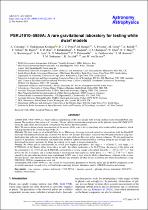| dc.description.abstract | Context. PSR J1910-5959A is a binary millisecond pulsar in a 0.837 day circular orbit around a helium white dwarf (HeWD) companion. The position of this pulsar is 6.3 arcmin (∼74 core radii) away from the optical centre of the globular cluster (GC) NGC 6752. Given the large offset, the association of the pulsar with the GC has been debated. Aims. We aim to obtain precise measurements of the masses of the stars in the system along with secular orbital parameters, which will help identify if the system belongs to the GC. Methods. We have made use of archival Parkes 64 m 'Murriyang'telescope data and carried out observations with the MeerKAT telescope with different backends and receivers over the last two decades. Pulse times of arrival were obtained from these using standard pulsar data reduction techniques and analysed using state-of-the-art Bayesian pulsar timing techniques. We also performed an analysis of the pulsar's total intensity and polarisation profile to understand the interstellar scattering along the line of sight, and we determined the pulsar's geometry by fitting the rotating vector model to the polarisation data. Results. We obtain precise measurements of several post-Keplerian parameters: the range, r = 0.202(6) TȮ, and shape, s = 0.999823(4), of the Shapiro delay, from which we infer: the orbital inclination to be 88.9-0.14+0.15 deg; the masses of the pulsar and the companion to be 1.55(7) MȮ and 0.202(6) MȮ, respectively; a secular change in the orbital period Pb = -53-6.0+7.4 × 10-15 s s-1 that proves the GC association; and a secular change in the projected semi-major axis of the pulsar, x = -40.7-8.2+7.3 × 10-16 s s-1, likely caused by the spin-orbit interaction from a misaligned HeWD spin, at odds with the likely isolated binary evolution of the system. We also discuss some theoretical models for the structure and evolution of white dwarfs in neutron star-white dwarf binaries, using PSR J1910-5959A's companion as a test bed. Conclusions. PSR J1910-5959A is a rare system for which several parameters of both the pulsar and the HeWD companion can be accurately measured. As such, it is a test bed for discriminating between alternative models of HeWD structure and cooling. | en_US |

